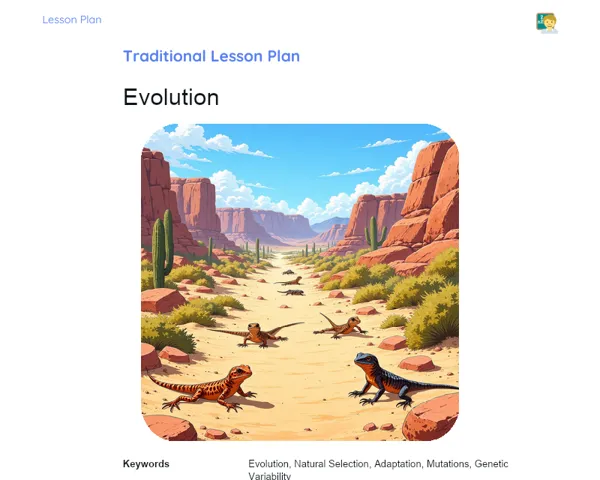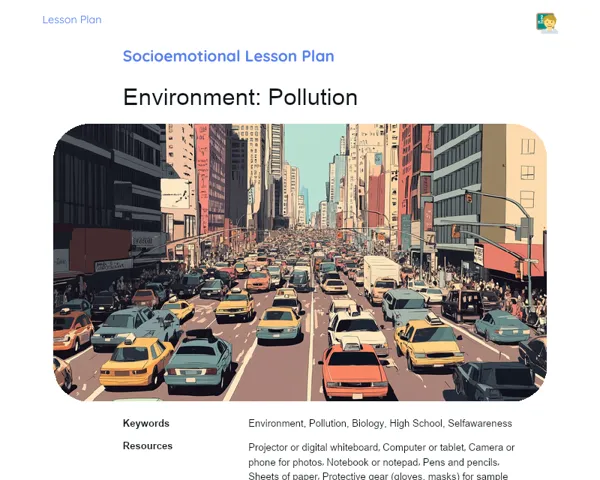Lesson Plan | Lesson Plan Tradisional | Ecology: Ecological Succession
| Keywords | Ecological Succession, Primary Succession, Secondary Succession, Pioneer Stage, Intermediate Stage, Climax Stage, Lichens, Mosses, Biodiversity, Environmental Conservation, Sustainable Management |
| Resources | Whiteboard and markers, Presentation slides on ecological succession, Short video on ecosystem recovery after disturbances, Images or illustrations showcasing primary and secondary succession, Worksheets for classroom activities, Paper and pens for note-taking, Computer and projector for displaying slides and videos |
Objectives
Duration: 10 - 15 minutes
This stage aims to introduce learners to the concept of ecological succession, offering an overview of the gradual shifts occurring within ecosystems and the species that are part of each stage. This introduction is vital in preparing learners for a more comprehensive understanding of the topic as the lesson progresses.
Objectives Utama:
1. Explain the concept of ecological succession, emphasising its stages and the gradual changes involved.
2. Identify and describe the species found in each stage of ecological succession.
3. Differentiate between primary and secondary succession, and provide relevant examples of each.
Introduction
Duration: 10 - 15 minutes
The intention of this section is to familiarise learners with the basics of ecological succession, outlining the gradual ecosystem changes and the species involved. This introduction is essential for a deeper investigation of the topic throughout the lesson.
Did you know?
Curiosity: Did you know that an area completely devastated by a wildfire can, over a number of years, recover beautifully and transform into a lush and diverse ecosystem? This is a classic example of ecological succession in action, illustrating the resilience of nature.
Contextualization
Start by explaining that ecology revolves around understanding how organisms interact with their environment. One important process within this field is ecological succession, which refers to the natural evolution and transformation of ecosystems over time. Outline that ecological succession unfolds in a series of predictable stages, leading from an area without life to a fully developed and stable ecosystem. Highlight the significance of understanding this process for conservation efforts and the sustainable management of our natural resources.
Concepts
Duration: 30 - 35 minutes
The aim of this section is to build on learners' knowledge of ecological succession, delving deeper into the types of succession, their stages, and the importance of these processes for biodiversity and ecological sustainability. By the end of this segment, learners should distinguish between primary and secondary succession, identify the species involved in each stage, and grasp the environmental impacts of ecological succession.
Relevant Topics
1. 🌱 Concept of Ecological Succession: Explain that ecological succession is the process whereby the structure of a biological community evolves over time. Generally, there are two types of ecological succession: primary and secondary.
2. 🌍 Primary Succession: Explain that this happens in an area devoid of soil or life, such as a new volcanic island or land exposed after a glacier melts. Discuss how pioneering species like lichens and mosses help in soil formation.
3. 🌳 Secondary Succession: Describe this as the process that occurs in areas where soil is already present but has had vegetation removed due to disturbances like fires, storms, or human actions. Stress that succession in these areas is generally quicker due to existing soil and seed banks.
4. ⚙️ Stages of Succession: Go over the main stages of ecological succession: pioneer stage, intermediate stage, and climax stage. Provide specific examples of species dominating each stage and how they modify their surroundings.
5. 🏞️ Importance of Ecological Succession: Discuss why understanding these processes is vital for enhancing biodiversity and aiding ecosystem restoration. Connect these concepts to environmental conservation, sustainable management, and share examples of successful recoveries.
To Reinforce Learning
1. What are the key differences between primary and secondary succession? Provide an example for each.
2. How do lichens and moss contribute to soil formation during primary succession?
3. What are the main features of the climax stage in a forest ecosystem?
Feedback
Duration: 20 - 25 minutes
The primary aim of this area is to reinforce what students have learned throughout the lesson, allowing them to apply, contemplate, and discuss concepts of ecological succession. By fostering discussions and reflection, the teacher drives a deeper and more critical understanding of ecological succession and its significant roles in biodiversity and sustainable ecosystems.
Diskusi Concepts
1. What is the key difference between primary succession and secondary succession? Primary succession occurs in areas lacking soil or life prior. Examples include new volcanic islands and lands exposed after glacier melts. Secondary succession, however, happens in areas where soil exists, but plant life has been lost due to disturbances like fires, storms, or human actions. An instance of secondary succession is the regrowth of a forest post-fire. 2. Explain how lichens and mosses help form soil in primary succession. Lichens and mosses are the pioneering species that settle on bare rock and other lifeless areas. They thrive in tough conditions, secreting acids that gradually break down rock, contributing to initial soil formation. As they die and decompose, they add organic matter to the new soil, creating favourable conditions for more complex plant life. 3. What are the primary characteristics of the climax stage in a forest ecosystem? The climax stage signifies the ecosystem's final structure, achieving stability and balance. In a forest ecosystem, this typically includes a mature community of trees like oaks and beeches that form a dense canopy. Biodiversity is at its peak, with an array of plants, animals, fungi, and microorganisms interacting in intricate ways. Environmental conditions such as temperature, light, and humidity are fairly stable, enabling the ecosystem to withstand minor disturbances.
Engaging Students
1. 🤔 Reflective Question: How do you think ecological succession could affect biodiversity within an ecosystem? 2. 🌱 Group Discussion: Think about an area that has faced natural disaster. What stages of succession would likely take place over time? How do pioneering species facilitate the establishment of subsequent species? 3. ⚖️ Debate: What are the positive and negative effects that human activities may have on ecological succession? What steps can be taken to encourage healthy ecosystem recovery? 4. 🌳 Practical Example: Can you think of a local example where ecological succession is evident? What observations do you have regarding the species and changes in the environment over time?
Conclusion
Duration: 10 - 15 minutes
This segment's aim is to solidify the knowledge gained during the lesson, summarising the main points and highlighting the practical relevance of the content. This ensures that learners depart with a clear understanding of the subject and feel motivated to apply this knowledge in real-life scenarios.
Summary
['Ecological succession is the process through which the structure of a biological community evolves over time.', 'There are two principal types of ecological succession: primary succession and secondary succession.', 'Primary succession occurs in lifeless areas without pre-existing soil, while secondary succession takes place where soil is available.', 'The stages of ecological succession include the pioneer stage, intermediate stage, and climax stage.', 'Lichens and mosses are pioneering species that initiate soil formation in primary successions.', 'The climax stage is marked by a stable, mature ecosystem with rich biodiversity.', 'Ecological succession is vital for biodiversity and ecosystem recovery, underscoring the importance of environmental conservation and sustainable management.']
Connection
The lesson bridged ecological succession theory with practical application by showcasing real-life instances of these processes, such as how regions impacted by fires recover and how lichens and mosses contribute to soil formation. This helped students visualise the gradual changes that ecosystems undergo in reality and the vital role played by each stage in promoting biodiversity and sustainability.
Theme Relevance
Comprehending ecological succession is fundamental to appreciating the resilience of ecosystems and the necessity of environmental conservation efforts. For example, understanding how an area can regenerate after degradation influences sustainable management approaches and recovery strategies for damaged ecosystems. Moreover, curiosity about nature's recovery from disasters can inspire learners to advocate for preservation of the environment.



